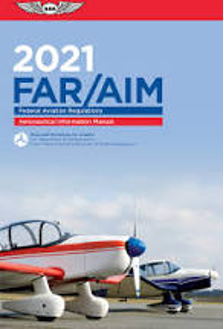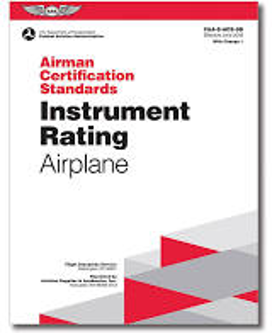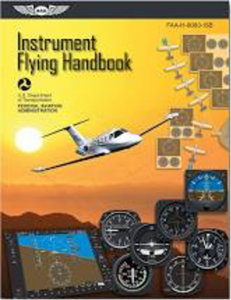Instrument Rating Requirements
IF you have been a ‘VFR’ pilot for many years and have decided to get your instrument rating, good for you!! You will improve your piloting skills and become a better pilot in the process. You have probably decided to do this to allow you to takeoff or get home when the weather is below ‘VFR’ minimums or ‘marginal’.
Here is what is required and includes some of the materials you will need as you work towards becoming instrument rated.
 You can also look this up in the FAR/AIM. And, yes, you will need a current copy of the FAR/AIM, especially if you are training for any certificate or rating. And, yes, it is updated yearly. There are always changes. Some are major and others are mino
You can also look this up in the FAR/AIM. And, yes, you will need a current copy of the FAR/AIM, especially if you are training for any certificate or rating. And, yes, it is updated yearly. There are always changes. Some are major and others are mino
According to FAR 61.65 (d), Instrument Rating Requirements; aeronautical experience for the instrument-airplane rating includes;
- 50 hours of cross-country time as Pilot In Command (PIC), of which 10 hours must be in an airplane (as opposed to helicopter)
- 40 hours of actual or simulated instrument time. Up to 20 hours can be in an approved ‘FTD’/flight training device.
- 3 hours of instrument flight training from an ‘authorized’ instructor in 2 calendar months before the date of the practical test. This is in case there is some ‘interruption’ in your training for whatever reason(s); it ensures that you fly with a CFII within the 2 calendar months before your ‘check ride’ to make sure you are ready/proficient and fly to ‘the ACS Standards’.
- Instrument training on cross country flight procedures, including one cross country flight in an airplane, with an authorized instructor, that is performed under IFR, when a flight plan has been filed with an ATC facility, that involves –
- A cross country flight of at least 250 nautical miles (NM) along airways or by directed routing by ATC, with an instrument approach at each airport, and 3 different kinds of approaches with the use of navigational systems (ILS/LOC/VOR/RNAV, etc.)
Here are some ‘pilot currency’ questions for you;
- Are you still current to act as PIC, or, has your PIC currency lapsed? How long has it been since you’ve flown?
- When was your last Flight Review, or are you in the FAA’s Wings Program?
- If you are in the Wings Program, actively doing both flight and ground activities, then you probably don’t need a Flight Review. That’s an incentive for you to participate in the program. Go to www.faasafety.gov to sign up for this.
There is no cost to sign up, nor are you obligated. Rather, this HELPS you to stay current! It tracks your progress whenever you complete a flight or ground ‘approved’ activity, and sends you email reminders of your progress.
- Do you have a current Medical? Or, has it expired? These are things to check!
In addition, you will also need;
To study and take the instrument flight rules (IFR) knowledge or written test. Unlike the training for your Private Pilot License, with the instrument rating, you really need to study for and take the IFR knowledge test BEFORE you begin training in the airplane or simulator. The reason? Instrument Flying, aka flying IFR, is all about Procedures. There are many. And there are regulations. And more. It gets complicated. It’s all spelled out in the FAR/AIM, and some other publications as well.
You need to learn the material BEFORE you get into the airplane or simulator. You really can’t learn this, effectively or well, in the airplane or simulator. You NEED to have at least a basic understanding of the procedures BEFORE you get into the airplane or simulator where you can then APPLY them, working with your instructor. This is one of the reasons that the FAA requires at least 40 hours of training for the instrument rating, not to mention ground school, along with pre and post flight briefings. There is a lot of material!
There are now many online courses that provide the necessary training for the knowledge test. Especially now with the COVID pandemic. That has changed everything, and now there are no in-person ground schools. Unless you are very disciplined and are good with self-study, I recommend this for most pilots, because there are so many ‘distractions’ in our daily lives now. Most good courses also offer a money-back guarantee in case you do not pass on the first attempt.
There are also several ‘official’ FAA publications that you will also need.
Some are now available in FREE, PDF format for a free download from the FAA’s website. They are: 
The FAA’s publication that spells out what is required of an ‘applicant’ for the Instrument Rating – Airplane, the Airman Certification Standards (ACS). It lists ALL of the requirements. It’s officially known as the FAA-S-ACS-8B, (with change 1). This was previously called the Practical Test Standards, or PTS. It was recently completely overhauled in an effort to update it and is now referred to as the ‘ACS’ for short. The current edition was issued in June 201
The Instrument Flying Handbook, or IFH. The official title; FAA-H-8083-15B. This is another FREE FAA publication that can be downloaded in PDF format.
This is from the FAA’s website; “This Instrument Flying Handbook is designed for use by instrument flight instructors and pilots preparing for instrument rating tests
 Instructors may find this handbook a valuable training aid as it includes basic reference material for knowledge testing and instrument flight training. Other Federal Aviation Administration (FAA) publications should be consulted for more detailed information on related topics.”
Instructors may find this handbook a valuable training aid as it includes basic reference material for knowledge testing and instrument flight training. Other Federal Aviation Administration (FAA) publications should be consulted for more detailed information on related topics.”
There are also many good instrument flying training manuals on the market. Talk with your CFI about this. You can find them at Sporty’s Pilot Shop, also see Rod Machado’s website, and Aviation Supplies and Academics websites, among others.
Software
Now that we have the technology, who uses paper charts anymore? Well, some still do. But now we have choices. And the iPad and Android have changed everything.
Among the available choices for flight planning software are –
ForeFlight Mobile. This is for the Apple iPad only, not Android. This was introduced about 10 years ago and has revolutionized flying. It’s become THE standard for many operators now, with digital charts, moving maps, weather imagery and more. This is available on a subscription basis. And ForeFlight now uses Jepp Charts as well as US Gov’t NOS charts. NOS (national oceanographic survey) charts are the default chart. You can get Jepp Charts for an additional fee. I use Jepps on my ForeFlight. It’s worth the extra charge, to me. I’ve been using Jepp Charts for over 40 years now.
WingX Pro. This is also an iPad app, and is very capable. This is also available via subscription.
Garmin Pilot – Another flight planning software application.
Fltplan Go. FltPlan.com is a FREE website that is widely used in corporate aviation for flight planning. There is also an app.
Syllabus
Recommended – SkyRoamers Instrument Pilot Flight Training Syllabus – Airplane and Simulator or FTD.
Also; Jeppesen Instrument/Commercial Syllabus, by Pilot Mall,
Also, Jeppesen Flite Training Instrument Student Guide
These are just a few. All of this covers some of the basics. I will be adding to this as needed.
Discuss all of this and more with your instructor, or reach out to me, and I will be glad to discuss this with you.
